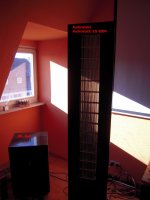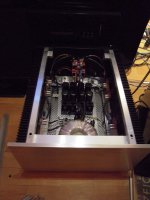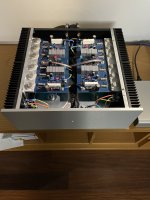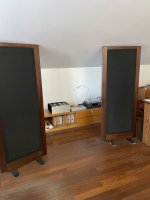Hi all.
Is F5t v2 suitable to drive planar speakers with 3R resistance or is it only good on 8R loads?
Is there anyone who has already done this experience?
All suggestions are accepted.
Cheers
Is F5t v2 suitable to drive planar speakers with 3R resistance or is it only good on 8R loads?
Is there anyone who has already done this experience?
All suggestions are accepted.
Cheers
https://firstwatt.com/pdf/prod_f5_man.pdf
A standard F5 "...will drive a 2 ohm load without burping, and 1 ohm without misbehaving."
What concerns you re: the Turbo?
https://firstwatt.com/pdf/art_f5_turbo.pdf
A standard F5 "...will drive a 2 ohm load without burping, and 1 ohm without misbehaving."
What concerns you re: the Turbo?
https://firstwatt.com/pdf/art_f5_turbo.pdf
Hello giubos,
I use my F5T-Monoblocks for more than 5 years now together with my Audiostatic ES300R - Electrostatic loudspeakers.
Fantastic combo! Very fast and detailed sound.
But I added a subwoofer (crosssoverfrequency at 80 Hz) to make the life of the ESLs easier.
Cheers
Dirk
I use my F5T-Monoblocks for more than 5 years now together with my Audiostatic ES300R - Electrostatic loudspeakers.
Fantastic combo! Very fast and detailed sound.
But I added a subwoofer (crosssoverfrequency at 80 Hz) to make the life of the ESLs easier.
Cheers
Dirk
Attachments
Hi Cubicincher,Hello giubos,
I use my F5T-Monoblocks for more than 5 years now together with my Audiostatic ES300R - Electrostatic loudspeakers.
Fantastic combo! Very fast and detailed sound.
But I added a subwoofer (crosssoverfrequency at 80 Hz) to make the life of the ESLs easier.
Cheers
Dirk
Thank you for your feedback, I know little about Audiostatic ES300R's, I know they are not easy to drive. My planars have an impedance of 2.7 R and I currently use an amp based on Rod's P 101. I redesigned the board by inserting another mosfet per rail to work better at low impedances using some old and always good 2SK135 and 2SJ50 mosfets I had in the lab.
I am very pleased with the result and the sound in general, I have never heard the midrange so realistic and present. Since I am curious and I have never tried a class A amplifier I wanted to understand if
F-5T could be the right amp for my planars.
F-5T v2 or V3 Monoblock?
In my opinion I should go for the Monoblock, I'm afraid 50W is not enough for the planars, John Taylor the manufacturer recommended 100W in classA.
I attach a picture of my amp.
Cheers
Attachments
hi,https://firstwatt.com/pdf/prod_f5_man.pdf
A standard F5 "...will drive a 2 ohm load without burping, and 1 ohm without misbehaving."
What concerns you re: the Turbo?
https://firstwatt.com/pdf/art_f5_turbo.pdf
thank you for your feedback.
I had not seen the manual at the link https://firstwatt.com/pdf/prod_f5_man.pdf
It was helpful , I thank you.
If you wanted to make a 100W class A what design would you use?
Maybe the F-5T v3 monoblock?
Cheers
Hi,
We would rather like to see a picture of the load = loudspeakers.
The impedance will not be a problem, I have been driving my Apogee's with the std. F5
It all depends on the sensitivity of the speakers and how loud you like to listen, and how big and absorbing the room is.
In the end the F5T v2 could be a an excellent starting point - as you could always step up to v3 (monos) from there later in the event that it isn't sufficiently powerful.
Do you ever drive the P101 into clipping in yout current setup - what voltage/power on this variant?
Cheers
We would rather like to see a picture of the load = loudspeakers.
The impedance will not be a problem, I have been driving my Apogee's with the std. F5
It all depends on the sensitivity of the speakers and how loud you like to listen, and how big and absorbing the room is.
In the end the F5T v2 could be a an excellent starting point - as you could always step up to v3 (monos) from there later in the event that it isn't sufficiently powerful.
Do you ever drive the P101 into clipping in yout current setup - what voltage/power on this variant?
Cheers
My pleasure...hi,
thank you for your feedback.
I had not seen the manual at the link https://firstwatt.com/pdf/prod_f5_man.pdf
It was helpful , I thank you.
If you wanted to make a 100W class A what design would you use?
Maybe the F-5T v3 monoblock?
Cheers
As Norgaard mentioned... I'd want to know 100W into what load? 100W into 3ohms differs from 100W into 8 ohms. Also... honestly... I've never build a 100W Class A amp. I likely never will. My speakers only need ~8W to reach ear splitting / hearing damaging levels in my room.
A "true" F5T v3 would be beyond what I'd do, personally due to my own needs. Also, building the amp with the diodes to allow that massive amount of current isn't something I'd likely find all that fun. There are just too many things that may go wrong and have gone wrong for others. I absolutely love chatting about the amp, and I find the topology fascinating... but my good ol' regular F5 is more than enough for my needs.
Now... if you really need/want all that power... I can heartily recommend the BA-3 'family'. Using a slew of output devices with the bias cranked, you can drive low-impedance loads very, very nicely. Also, if you really need the voltage swing to go along with it, you can build them balanced. They'll get you there.
A lot of this is just a matter of preference vs. backed by any real thought. Enjoy!
Hi Norgaard,Hi,
We would rather like to see a picture of the load = loudspeakers.
The impedance will not be a problem, I have been driving my Apogee's with the std. F5
It all depends on the sensitivity of the speakers and how loud you like to listen, and how big and absorbing the room is.
In the end the F5T v2 could be a an excellent starting point - as you could always step up to v3 (monos) from there later in the event that it isn't sufficiently powerful.
Do you ever drive the P101 into clipping in yout current setup - what voltage/power on this variant?
Cheers
thanks for your feedback, the planars I use have an impedance of 2.7R resistive only (no crossover).
The power amp I currently use has a power on the right channel of 171.8 W and on the left channel 172.1 W on 8R. On 4R about 300 W (the right 304.2 W and the left 305 W).
I never clipped the amp even when listening at a good sound level.
The floor is wood and the windows all have curtains in front.
The room is 5x6 meters and fairly neutral, maybe the bass a bit back. I listen mostly to live recorded jazz. When I can I frequently go to concerts and in my listening room I tend to reproduce the sound of the concert, light dimmed and in front of me I have the concert stage with the same sound intensity as I heard live. The backup power is for musical transients and keeping the dynamics high. After all, planar speakers are not for disco. Ultimately I think I will follow your suggestion and the F-5T V2 will be a good starting point, also considering that I can switch to monoblock in the future. Thanks again for the feedback.
Cheers
Attachments
Hi,My pleasure...
As Norgaard mentioned... I'd want to know 100W into what load? 100W into 3ohms differs from 100W into 8 ohms. Also... honestly... I've never build a 100W Class A amp. I likely never will. My speakers only need ~8W to reach ear splitting / hearing damaging levels in my room.
A "true" F5T v3 would be beyond what I'd do, personally due to my own needs. Also, building the amp with the diodes to allow that massive amount of current isn't something I'd likely find all that fun. There are just too many things that may go wrong and have gone wrong for others. I absolutely love chatting about the amp, and I find the topology fascinating... but my good ol' regular F5 is more than enough for my needs.
Now... if you really need/want all that power... I can heartily recommend the BA-3 'family'. Using a slew of output devices with the bias cranked, you can drive low-impedance loads very, very nicely. Also, if you really need the voltage swing to go along with it, you can build them balanced. They'll get you there.
A lot of this is just a matter of preference vs. backed by any real thought. Enjoy!
to give you an idea I had an old 50W Rotel that I used with 8R cone speakers and on 2.7R planars it would freeze and go into protection. I could play with a 75W sansui on 8R but the sound was flat with no dynamics. I'm currently pretty happy with the sound but have never tried a class A and am curious.
I would be inclined to try the F-5T V2 , but I want to take your advice and read more about the BA-3 Family.
Thanks for the feddback
Cheers
Translated with www.DeepL.com/Translator (free version)
That makes sense... particularly if the old Rotel was a bit 'light' on it's ability to provide the necessary current when you wanted to make the earth move under your feet... it'd be particularly 'bad' if the planars also were a bit more inefficient from a voltage standpoint. As an example... the manufacturer of my speakers (roughly 4 ohm, but with dips) advertises their sensitivity with 2V83 input. Well, that's all fine and dandy, but that's 2W. It's not 1W.Hi,
to give you an idea I had an old 50W Rotel that I used with 8R cone speakers and on 2.7R planars it would freeze and go into protection.
Finding a "match" for each person's speakers is interesting. Heck, I think that's 99% of the fun with HiFi. If every amp or speaker were 'perfect' or even if most people could agree on what 'perfect' meant.... it would be boring. 😀I could play with a 75W sansui on 8R but the sound was flat with no dynamics. I'm currently pretty happy with the sound but have never tried a class A and am curious.
I would be inclined to try the F-5T V2 , but I want to take your advice and read more about the BA-3 Family.
Thanks for the feddback
Cheers
Translated with www.DeepL.com/Translator (free version)
You won't go wrong with many choices. I usually lean toward the opinion of those with similar speakers. Dirk can even do gymnast routines with his amps. 😀
Hi , yes it is true the combination of electronics and speakers and all mixed with the environment is the essence of hi fi .
I will ask Dirk for some clarifications.
Thanks for the feddback and have a good listen .
Cheers
I will ask Dirk for some clarifications.
Thanks for the feddback and have a good listen .
Cheers
Hello giubos,
I use my F5T-Monoblocks for more than 5 years now together with my Audiostatic ES300R - Electrostatic loudspeakers.
Fantastic combo! Very fast and detailed sound.
But I added a subwoofer (crosssoverfrequency at 80 Hz) to make the life of the ESLs easier.
Cheers
Dirk
Hello giubos,
I use my F5T-Monoblocks for more than 5 years now together with my Audiostatic ES300R - Electrostatic loudspeakers.
Fantastic combo! Very fast and detailed sound.
But I added a subwoofer (crosssoverfrequency at 80 Hz) to make the life of the ESLs easier.
Cheers
Dirk
Hello giubos,
I use my F5T-Monoblocks for more than 5 years now together with my Audiostatic ES300R - Electrostatic loudspeakers.
Fantastic combo! Very fast and detailed sound.
But I added a subwoofer (crosssoverfrequency at 80 Hz) to make the life of the ESLs easier.
Cheers
Dirk
Hi Dirk,Hello giubos,
I use my F5T-Monoblocks for more than 5 years now together with my Audiostatic ES300R - Electrostatic loudspeakers.
Fantastic combo! Very fast and detailed sound.
But I added a subwoofer (crosssoverfrequency at 80 Hz) to make the life of the ESLs easier.
Cheers
Dirk
we seem to have more affinity and so I will ask you some clarifications.
I am 68 years old and my hearing is good, I listen mostly to jazz recorded live. My ear reaches from 30 to 15000 hz,
Below 30 HZ I only hear my stomach vibrate above 15000 I hear nothing. Having said that I wanted to know what impedance your ES300s have and what bandwidth .
My Yankee Audio go from 25 to 20000 HZ which for me is more than enough. Getting to the questions.
Is it the speakers that need help on the low end or is it the amp not performing well enough on the low end? Or do you use a crossover to not fatigue the speakers, but would they have the ability to reproduce low frequencies without help? That is, without feeling the bass a bit behind?
Second question Could you use F-5T V2 50 Watts Class A instead of Monoblocks 100 Watts or do you need all 100 Watts?
Where i can find the pcb , Diyaudio store, is that correct?
Thanks Dirk, sorry for my curiosity.
I am intending to build the F-5T V3 monoblock, if you have any advice I would welcome it.
Cheers
Giubos
Translated with www.DeepL.com/Translator (free version)
Giubos,
Maybe you can try this test using your existing amp:
https://www.diyaudio.com/community/...h-voltage-power-do-your-speakers-need.204857/
Building an F5 turbo is a non-trivial endeavour and it would it would be a shame to build one only to find if it isn't power enough for your use. Doing that test will help you size the amp appropriately.
Maybe you can try this test using your existing amp:
https://www.diyaudio.com/community/...h-voltage-power-do-your-speakers-need.204857/
Building an F5 turbo is a non-trivial endeavour and it would it would be a shame to build one only to find if it isn't power enough for your use. Doing that test will help you size the amp appropriately.
Hello Giubos,
in my experience ESLs can improve soundwise a lot by using a subwoofer. The danger is that at high listening levels the foil
could touch the stators caused by the large excursion of the foil. This can happen with music with a lot /deep bass frequencies.
But you have to find a 'fast' subwoofer.
My Audiostatic are full range electrostats with one foil for the complete frequency range. No two-way with seperated foils.
The Audiostatic have a good sensitivity around 88 -89dB/W/m and the impedance doesn't go that low as some MLs or other
ESLs.

The lower graph shows the behaviour with a impedance linearization / compensation (I hope this is the correct term),
the upper curve is the original impedance curve.
I think you can drive your speakers with a F5 V2 or a BA-3 to surprising levels. I have also used my BA-3 to drive my ESLs.
In my opinion soundpressure level drops in ESLs are often caused by aging of the foils, damages to the transformers,...
And if I compare the F5T with the BA-3: F5 is a very clear and analytic sounding amp (also depends on the speaker),
BA-3 makes a bit more in the bass-region, but is also very good in mids and highs. Both are excellent amps.
I hope this helps a bit.
Cheers
Dirk
in my experience ESLs can improve soundwise a lot by using a subwoofer. The danger is that at high listening levels the foil
could touch the stators caused by the large excursion of the foil. This can happen with music with a lot /deep bass frequencies.
But you have to find a 'fast' subwoofer.
My Audiostatic are full range electrostats with one foil for the complete frequency range. No two-way with seperated foils.
The Audiostatic have a good sensitivity around 88 -89dB/W/m and the impedance doesn't go that low as some MLs or other
ESLs.
The lower graph shows the behaviour with a impedance linearization / compensation (I hope this is the correct term),
the upper curve is the original impedance curve.
I think you can drive your speakers with a F5 V2 or a BA-3 to surprising levels. I have also used my BA-3 to drive my ESLs.
In my opinion soundpressure level drops in ESLs are often caused by aging of the foils, damages to the transformers,...
And if I compare the F5T with the BA-3: F5 is a very clear and analytic sounding amp (also depends on the speaker),
BA-3 makes a bit more in the bass-region, but is also very good in mids and highs. Both are excellent amps.
I hope this helps a bit.
Cheers
Dirk
I think you will need that 100 watts, but into the 2.7 ohm figure, so the supply voltage would resemble the value appropriate to a 30 or 40 watt figure at 8 Ohms, something like +/-30V, and with generous allowance for current.


Hi Nelson,I think you will need that 100 watts, but into the 2.7 ohm figure, so the supply voltage would resemble the value appropriate to a 30 or 40 watt figure at 8 Ohms, something like +/-30V, and with generous allowance for current.

thanks for the feedback.
So if I understand right ,I could start with F-5T V2 which has 50W power on 8R. But the doubt arises for me. At 2.7R, does the F-5T V2 remain in class A, and how many watts can it put out, even with a generously sized power supply?
I already have a class AB amp that sounds good and wanted to try a pure class A.
Thank you very much for your interest.
Cheers
Giubos
Hi Dirk,Hello Giubos,
in my experience ESLs can improve soundwise a lot by using a subwoofer. The danger is that at high listening levels the foil
could touch the stators caused by the large excursion of the foil. This can happen with music with a lot /deep bass frequencies.
But you have to find a 'fast' subwoofer.
My Audiostatic are full range electrostats with one foil for the complete frequency range. No two-way with seperated foils.
The Audiostatic have a good sensitivity around 88 -89dB/W/m and the impedance doesn't go that low as some MLs or other
ESLs.
View attachment 1022577
The lower graph shows the behaviour with a impedance linearization / compensation (I hope this is the correct term),
the upper curve is the original impedance curve.
I think you can drive your speakers with a F5 V2 or a BA-3 to surprising levels. I have also used my BA-3 to drive my ESLs.
In my opinion soundpressure level drops in ESLs are often caused by aging of the foils, damages to the transformers,...
And if I compare the F5T with the BA-3: F5 is a very clear and analytic sounding amp (also depends on the speaker),
BA-3 makes a bit more in the bass-region, but is also very good in mids and highs. Both are excellent amps.
I hope this helps a bit.
Cheers
Dirk
thanks for the news it was helpful to me to better understand which way to go with my class A amplifier.
Thank you very much.
Cheers
Hi thanks for the feedback,Giubos,
Maybe you can try this test using your existing amp:
https://www.diyaudio.com/community/...h-voltage-power-do-your-speakers-need.204857/
Building an F5 turbo is a non-trivial endeavour and it would it would be a shame to build one only to find if it isn't power enough for your use. Doing that test will help you size the amp appropriately.
I will try test.
Cheers
Giubos
I agree with NP. You'll need 100W/ch. I'm basing this on driving a pair of older Maggies MGIIc's. I was using his A-40 push pull design rated at 40w/ch and it would start clipping hard at a level around 85-90dba. This is with an over designed power supply being dual mono with 625VA xfmrs and CRC filtering. Maggies are tuff load also. Especially the older ones. Switched to the honey badger and it would handle them quite well. If you did offload the bass into a sub though then a V2 might get you there. I tried that with Maggies and Acoustats and never did like the bass as well as just running full range. Just one note I'm getting ready to try and run my A-40 bridged but my load stays between 8-10 throughout range with newer speakers. A-40 can handle 4-5ohm load w/o problems.
Hi,I agree with NP. You'll need 100W/ch. I'm basing this on driving a pair of older Maggies MGIIc's. I was using his A-40 push pull design rated at 40w/ch and it would start clipping hard at a level around 85-90dba. This is with an over designed power supply being dual mono with 625VA xfmrs and CRC filtering. Maggies are tuff load also. Especially the older ones. Switched to the honey badger and it would handle them quite well. If you did offload the bass into a sub though then a V2 might get you there. I tried that with Maggies and Acoustats and never did like the bass as well as just running full range. Just one note I'm getting ready to try and run my A-40 bridged but my load stays between 8-10 throughout range with newer speakers. A-40 can handle 4-5ohm load w/o problems.
I would like to try F-5T and am undecided on V2 0 Monoblock V3. My speakers have an impedance of 2.7 R resistive only. I don't understand if F-5T V2 or V3 can drive at 2.7R while remaining class A. You mentioned that if I dump the bass to a subwoofer a V2 might make it. V2 or V3?
I currently use a Class AB dual mono with two 800 VA toroids that give me good current coverage at low impedance. Class A is supposed to work at constant current, but what happens if we lower the impedance?
Thanks for your feedback
Cheers
- Home
- Amplifiers
- Pass Labs
- F-5T V2 and planars R3



